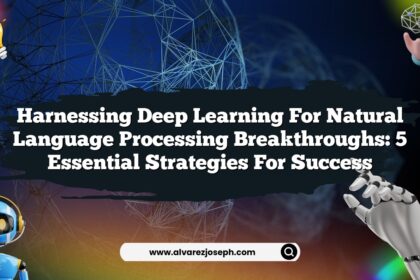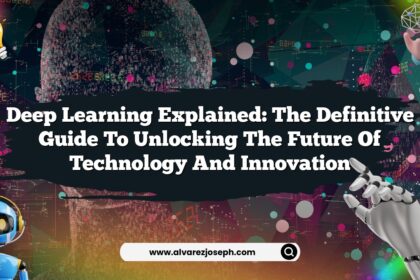Imagine a world where robots navigate through complex environments, learning from their experiences and adapting in real time. Sounds like a scene straight out of a sci-fi movie, right? Well, the truth is, we are inching closer to that reality with the incredible advancements in deep learning within the field of robotics. This powerful blend of artificial intelligence and machine learning is not just about building fancy robots; it’s about revolutionizing automation and enhancing efficiency across various industries. In this article, we will dive into five essential strategies that can reshape the future of robotics through deep learning. So, fasten your seatbelt; it’s going to be an enlightening ride!
Understanding Deep Learning in Robotics
Deep learning, a subset of machine learning, involves training artificial neural networks to recognize patterns and make decisions. This process mimics how humans learn from experience, making it particularly effective in robotics. Robots equipped with deep learning capabilities can analyze vast amounts of data, enabling them to perform complex tasks that were once thought to be exclusively human domains.
Why does this matter? The implications for industries like manufacturing, healthcare, logistics, and even agriculture are profound. Imagine robots that can predict machine failures before they happen, or drones that can optimize delivery routes in real time. The potential is staggering, and it all begins with a solid understanding of the strategies that can harness deep learning in robotics.
Strategy 1: Embrace Real-Time Learning
The first strategy to supercharge automation with deep learning is to embrace real-time learning. This approach involves allowing robots to learn and adapt on the fly. Instead of relying solely on pre-programmed instructions, robots can utilize data from their surroundings to refine their actions continuously.
Consider a self-driving car. It uses sensors and cameras to gather data about its environment—traffic signals, pedestrians, road conditions—and adjusts its behavior accordingly. If a self-driving car encounters a new type of obstacle, it can quickly learn to navigate around it without human intervention. This capability not only enhances safety but also increases operational efficiency.
Real-time learning can be achieved through reinforcement learning, where robots receive feedback based on their actions. With each successful maneuver, they get closer to mastering their tasks. The more they practice, the better they become—just like us trying to perfect that tricky recipe!
Benefits of Real-Time Learning
- Increased Adaptability: Robots can adjust to unforeseen circumstances, making them more reliable.
- Improved Efficiency: Continuous learning means that robots can optimize their performance over time.
- Enhanced Safety: By learning from mistakes, robots can minimize risks in hazardous environments.
But what happens when a robot makes a mistake? That leads us to strategy number two…
Strategy 2: Implement Advanced Error Correction
Errors are inevitable in any learning process, and robotics is no exception. Implementing advanced error correction mechanisms is crucial to ensure that robots not only learn from their mistakes but also improve their performance over time.
This strategy involves incorporating algorithms that can identify when a robot has made an error and learn from it. For example, if a robot arm misplaces an item on an assembly line, it should be able to analyze that mistake, understand why it happened, and adjust its approach in the future.
A fascinating example is the way robots in manufacturing have been trained to detect errors in real time. By analyzing video feeds and sensor data, these robots can figure out what went wrong and correct their methods on the spot. This self-correcting behavior enhances overall productivity and reduces waste.
Key Features of Advanced Error Correction
- Self-Assessment: Robots can evaluate their performance and identify areas for improvement.
- Data-Driven Insights: By analyzing past errors, robots can adapt their strategies, leading to fewer mistakes.
- Increased Reliability: With fewer errors, robots become more dependable in critical operations.
Curious about how robots handle complex tasks? Let’s explore the next strategy that focuses on learning from human expertise.
Strategy 3: Leverage Human-in-the-Loop Systems
Imagine a cooking show where a master chef guides a novice through preparing a gourmet meal. This mentorship is akin to the human-in-the-loop systems used in robotics to enhance deep learning. By integrating human expertise into the training process, robots can learn more effectively and efficiently.
In this strategy, robots operate alongside human operators who provide real-time feedback. This interaction allows robots to absorb knowledge and skills that would take much longer to learn through independent learning. For instance, in a warehouse setting, a robot can learn the nuances of stacking items correctly by observing and interacting with its human counterparts.
The beauty of human-in-the-loop systems lies in their ability to combine the strengths of both human intuition and machine learning. Humans excel at strategic thinking and problem-solving, while robots can process data at lightning speed. By working together, they can achieve results that neither could independently.
Advantages of Human-in-the-Loop Systems
- Accelerated Learning: Robots benefit from human insights, speeding up their training process.
- Enhanced Performance: Collaborative learning leads to improved outcomes compared to isolated training.
- Greater Flexibility: Robots can adapt to new tasks more quickly when guided by human expertise.
Ever wondered how robots can handle unforeseen challenges? Let’s dive into our next strategy: utilizing simulated environments.
Strategy 4: Create Simulated Learning Environments
In a world where practice makes perfect, simulated learning environments offer robots a unique opportunity to hone their skills without the risks associated with real-world training. By creating controlled environments that mimic real-life scenarios, robots can practice various tasks and learn from their experiences.
This strategy is particularly important in fields like healthcare, where robots can practice surgeries or patient interactions in a virtual setting before attempting them in real life. These simulations provide a safe space for trial and error, allowing robots to refine their skills without endangering anyone.
Moreover, simulated environments can be endlessly varied, which is crucial for developing robots that can adapt to different situations. For example, a delivery drone can practice navigating through urban landscapes, rural areas, and even extreme weather conditions—all within a virtual framework.
Benefits of Simulated Learning Environments
- Risk-Free Training: Robots can make mistakes without real-world consequences.
- Diverse Scenarios: Multiple simulated scenarios help robots prepare for various challenges.
- Cost-Effective: Reduced need for physical resources saves time and money in training.
But how do we ensure these robots are learning effectively? That’s where our final strategy comes into play.
Strategy 5: Utilize Continuous Performance Evaluation
The final strategy to revolutionize automation through deep learning in robotics is to utilize continuous performance evaluation. This involves regularly assessing a robot’s abilities and providing feedback to foster ongoing improvement.
Continuous evaluation can take many forms, from periodic skill assessments to real-time monitoring of a robot’s performance during tasks. For instance, a robotic arm on an assembly line can be assessed based on its precision and speed, ensuring that it meets quality standards continuously.
The key to success with this strategy is data collection. By analyzing performance metrics over time, you can identify trends that indicate areas for improvement. This approach not only helps in refining individual robots but also contributes to the development of more advanced algorithms for future models.
Key Aspects of Continuous Performance Evaluation
- Data-Driven Insights: Regular assessments provide valuable data to inform training strategies.
- Enhanced Accountability: Continuous evaluation ensures that robots meet performance standards.
- Long-Term Improvement: Ongoing assessment leads to consistent evolution and adaptation.
With these five strategies in your toolkit, you now have a roadmap to harness the power of deep learning in robotics. This journey isn’t just about technology; it’s a collaborative effort that combines human ingenuity with the capabilities of machines.
Quick Summary
- Real-Time Learning: Enables robots to adapt and learn from their environments continuously.
- Advanced Error Correction: Helps robots learn from their mistakes and improve performance.
- Human-in-the-Loop Systems: Integrates human feedback for accelerated learning.
- Simulated Learning Environments: Provides risk-free training for robots.
- Continuous Performance Evaluation: Ensures ongoing improvement through regular assessments.
Frequently Asked Questions
What is deep learning in robotics?
Deep learning in robotics refers to the use of artificial neural networks to enable robots to learn and adapt from experiences, improving their performance over time.
How can robots learn in real-time?
Robots can learn in real-time by using sensors and algorithms that allow them to gather data from their surroundings and adjust their actions based on that data.
What are the benefits of using simulated environments for training robots?
Simulated environments allow robots to practice tasks without real-world risks, offering a safe space for trial and error while preparing them for various scenarios.
How does human-in-the-loop training work?
In human-in-the-loop training, robots work alongside human operators who provide real-time feedback, enhancing the robot’s learning process.
Why is continuous performance evaluation important?
Continuous performance evaluation ensures that robots are consistently monitored and assessed, helping to identify areas for improvement and promote long-term adaptability.
What industries can benefit from deep learning in robotics?
Industries such as manufacturing, healthcare, logistics, and agriculture can significantly benefit from the advancements in deep learning within robotics, enhancing efficiency and productivity.
As we explore the fascinating world of deep learning in robotics, one thing becomes clear: the future is not just about machines but about the synergy between humans and robots working together to create a more efficient and automated world. And you, how would you apply these insights in your life?












